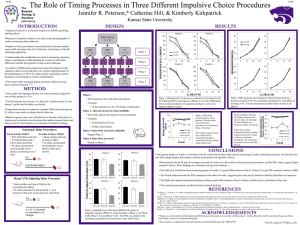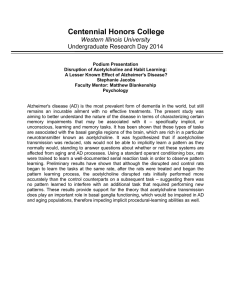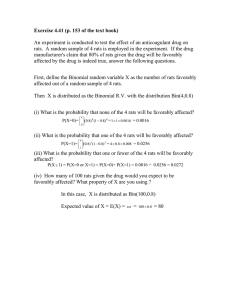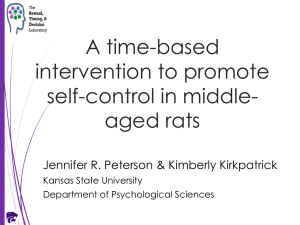Measurement of impulsive choice in rats: I. Preliminary assessment
advertisement
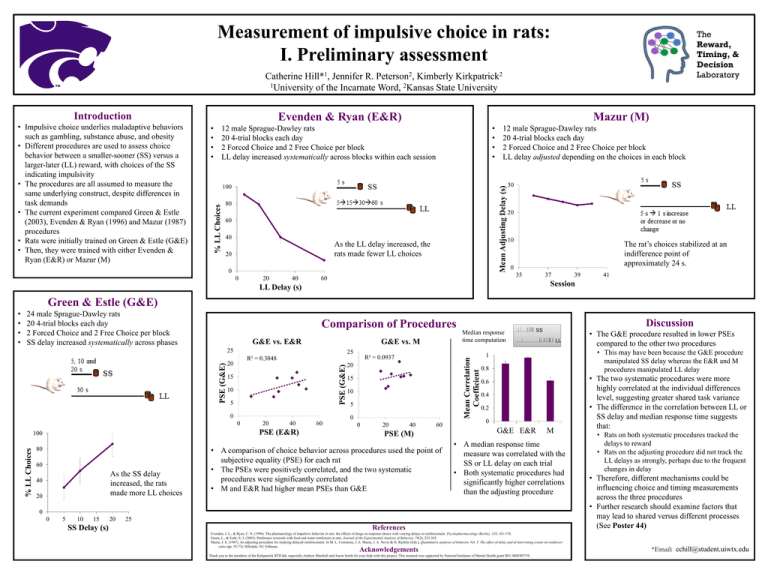
Measurement of impulsive choice in rats: I. Preliminary assessment 1 Hill* , 2 Peterson , 2 Kirkpatrick Catherine Jennifer R. Kimberly 1University of the Incarnate Word, 2Kansas State University Introduction • • • • Mazur (M) • • • • 12 male Sprague-Dawley rats 20 4-trial blocks each day 2 Forced Choice and 2 Free Choice per block LL delay increased systematically across blocks within each session 80 60 40 As the LL delay increased, the rats made fewer LL choices 20 0 0 20 40 12 male Sprague-Dawley rats 20 4-trial blocks each day 2 Forced Choice and 2 Free Choice per block LL delay adjusted depending on the choices in each block Mean Adjusting Delay (s) 100 % LL Choices • Impulsive choice underlies maladaptive behaviors such as gambling, substance abuse, and obesity • Different procedures are used to assess choice behavior between a smaller-sooner (SS) versus a larger-later (LL) reward, with choices of the SS indicating impulsivity • The procedures are all assumed to measure the same underlying construct, despite differences in task demands • The current experiment compared Green & Estle (2003), Evenden & Ryan (1996) and Mazur (1987) procedures • Rats were initially trained on Green & Estle (G&E) • Then, they were trained with either Evenden & Ryan (E&R) or Mazur (M) Evenden & Ryan (E&R) 60 30 20 10 The rat’s choices stabilized at an indifference point of approximately 24 s. 0 35 37 39 41 Session LL Delay (s) Green & Estle (G&E) 24 male Sprague-Dawley rats 20 4-trial blocks each day 2 Forced Choice and 2 Free Choice per block SS delay increased systematically across phases Comparison of Procedures 10 5 20 40 PSE (E&R) 60 As the SS delay increased, the rats made more LL choices 40 20 20 15 10 5 0 0 80 Mean Correlation Coefficient 15 0 100 R² = 0.0937 R² = 0.3048 PSE (G&E) PSE (G&E) 25 20 Median response time computation G&E vs. M G&E vs. E&R 25 % LL Choices • • • • 60 0 20 40 60 PSE (M) • A comparison of choice behavior across procedures used the point of subjective equality (PSE) for each rat • The PSEs were positively correlated, and the two systematic procedures were significantly correlated • M and E&R had higher mean PSEs than G&E Discussion SS LL • This may have been because the G&E procedure manipulated SS delay whereas the E&R and M procedures manipulated LL delay 1 0.8 0.6 0.4 0.2 0 G&E E&R M • A median response time measure was correlated with the SS or LL delay on each trial • Both systematic procedures had significantly higher correlations than the adjusting procedure 0 0 5 10 15 SS Delay (s) 20 • The G&E procedure resulted in lower PSEs compared to the other two procedures 25 References Evenden, J. L., & Ryan, C. N. (1996). The pharmacology of impulsive behavior in rats: the effects of drugs on response choice with varying delays to reinforcement. Psychopharmacology (Berlin), 128, 161-170. Green, L., & Estle, S. J. (2003). Preference reversals with food and water reinforcers in rats. Journal of the Experimental Analysis of Behavior, 79(2), 233-242. Mazur, J. E. (1987). An adjusting procedure for studying delayed reinforcement. In M. L. Commons, J. E. Mazur, J. A. Nevin & H. Rachlin (Eds.), Quantitative analyses of behavior. Vol. 5. The effect of delay and of intervening events on reinforcer value (pp. 55-73). Hillsdale, NJ: Erlbaum. Acknowledgements Thank you to the members of the Kirkpatrick RTD lab, especially Andrew Marshall and Aaron Smith for your help with this project. This research was supported by National Institutes of Mental Health grant R01-MHO85739. • The two systematic procedures were more highly correlated at the individual differences level, suggesting greater shared task variance • The difference in the correlation between LL or SS delay and median response time suggests that: • Rats on both systematic procedures tracked the delays to reward • Rats on the adjusting procedure did not track the LL delays as strongly, perhaps due to the frequent changes in delay • Therefore, different mechanisms could be influencing choice and timing measurements across the three procedures • Further research should examine factors that may lead to shared versus different processes (See Poster 44) *Email: cchill@student.uiwtx.edu




